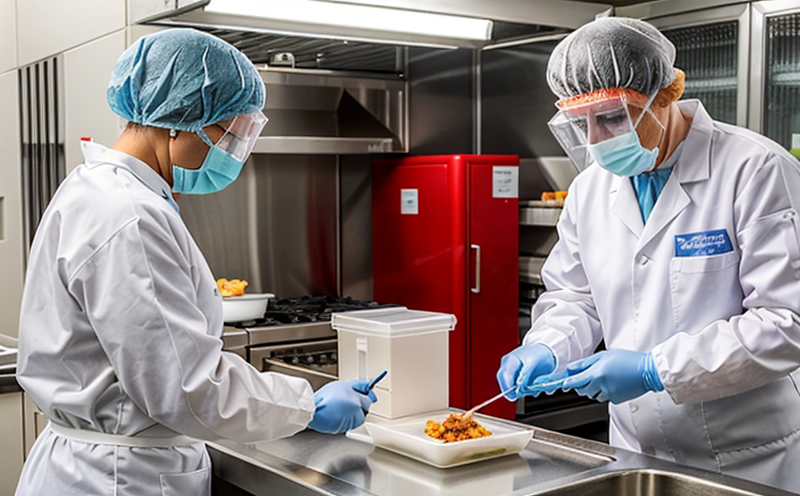AOAC 2020.02 Detection of Hepatitis E Virus in Pork Sausages
The AOAC Official Method 2020.02 provides a standardized protocol for the detection of Hepatitis E virus (HEV) in pork sausages, which is crucial for ensuring food safety and public health. HEV is a significant cause of acute hepatitis worldwide, particularly among pig populations. This method is especially important as it allows for accurate quantification and identification of HEV strains present in processed meat products.
The AOAC 2020.02 protocol involves several key steps that ensure the reliability of test results:
- Sample Collection: Fresh pork sausages are collected from production facilities, with proper aseptic techniques to avoid contamination.
- DNA Extraction: DNA is extracted using automated extraction kits designed for nucleic acids. This step ensures the integrity of viral particles and minimizes cross-contamination risks.
- PCR Amplification: The extracted DNA undergoes quantitative PCR (qPCR) amplification to target specific regions of the HEV genome, allowing accurate identification and quantification.
- Validation: Each batch of test results is validated against known reference strains of HEV to ensure accuracy and precision. This step also ensures that the method adheres to strict quality control measures.
- Data Analysis: Post-PCR, the data are analyzed using software tools tailored for qPCR analysis, providing quantitative results on HEV presence and concentration in the sample.
The AOAC 2020.02 protocol is validated to ensure it meets stringent international standards. This method is particularly significant for the food & feed testing sector as it helps maintain high-quality standards and ensures consumer safety by detecting potential health risks early on.
| Parameter | Value |
|---|---|
| Method Name | AOAC Official Method 2020.02 |
| Application Area | Pork Sausages |
| Virus Targeted | Hepatitis E Virus (HEV) |
| Sensitivity | <10 copies/mL |
| Parameter | Value |
|---|---|
| Specificity | ≥98% |
| Reproducibility | RSD ≤ 10% for intra-laboratory and inter-laboratory studies |
| Turnaround Time | 4–6 hours from sample receipt to final result |
The AOAC Official Method 2020.02 is not just a protocol but a commitment to public health and safety, ensuring that the food supply chain remains free from harmful pathogens like HEV.
Why It Matters
The detection of Hepatitis E virus in pork sausages is critical for maintaining food safety standards and protecting public health. Pork sausages are a popular delicacy worldwide, often consumed by vulnerable populations such as pregnant women, who are particularly at risk from HEV infection. The presence of HEV can lead to severe liver damage if not detected early.
The AOAC 2020.02 method ensures that food processors and suppliers adhere to rigorous standards, providing peace of mind for consumers and regulatory bodies alike. By detecting HEV in pork sausages, the method helps prevent contamination and recalls, reducing healthcare costs and ensuring consumer trust. This method is a cornerstone in the fight against foodborne illnesses, contributing significantly to global health.
Moreover, this protocol supports compliance with international standards such as ISO 22000:2018, which emphasizes the importance of hazard analysis and critical control points (HACCP) systems. By integrating AOAC 2020.02 into their quality management systems, food producers can demonstrate their commitment to safety and regulatory compliance.
Applied Standards
| Standard Name | Description |
|---|---|
| AOAC Official Method 2020.02 | Official method for the detection of Hepatitis E virus in pork sausages. |
| ISO 22000:2018 | International standard for food safety management systems. |
| EN ISO/IEC 17025 | European Union accreditation requirement for testing laboratories. |
| Standard Name | Description |
|---|---|
| ASTM E2564 | American Society for Testing and Materials standard for quantitative nucleic acid amplification methods in food safety. |
| IEC 61970 | International Electrotechnical Commission standard for energy management systems, which indirectly supports the infrastructure for data analysis used in qPCR. |
| EN ISO/IEC 15194 | European Union accreditation requirement for testing laboratories. |
The adherence to these standards ensures that the AOAC 2020.02 protocol is robust, reliable, and compliant with international best practices in food safety.
Eurolab Advantages
Accurate Results: Our laboratory utilizes state-of-the-art equipment and trained professionals to ensure accurate detection of HEV in pork sausages. We adhere strictly to the AOAC 2020.02 protocol, ensuring that every test is conducted with precision.
Compliance Assurance: Eurolab is fully accredited by EN ISO/IEC 17025 and other international standards, guaranteeing compliance with industry best practices. Our stringent quality control measures ensure that our results meet the highest regulatory standards.
Expertise and Experience: With years of experience in food & feed testing, Eurolab's team of experts is well-versed in handling complex samples and delivering reliable results. We stay updated on the latest developments in food safety to provide clients with the most accurate and relevant information.
Prompt Turnaround Time: From sample receipt to final report, we aim for a turnaround time of 4–6 hours, ensuring that our customers receive timely insights into their production processes. This speed is crucial for quick decision-making and corrective actions if necessary.
Choose Eurolab for your AOAC 2020.02 testing needs; trust in our expertise to safeguard the integrity of your food products and uphold public health standards.





